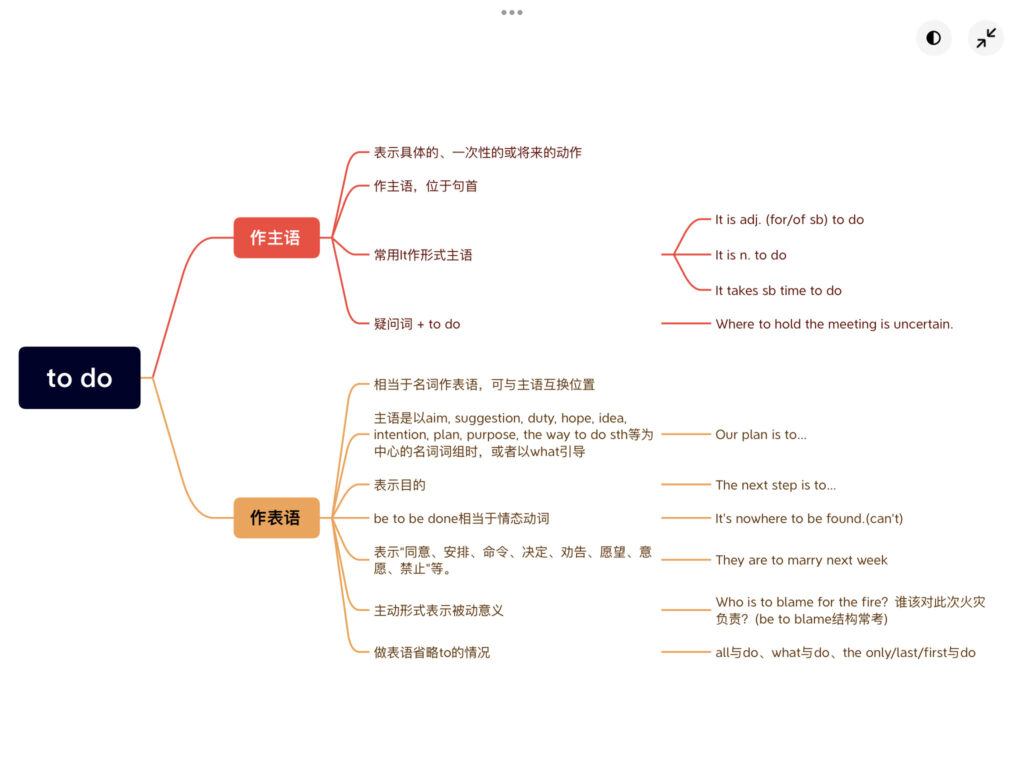不定式作主语
不定式作主语,表示具体的、一次性的或将来的动作;在很多情况下,人们通常用it作为形式上的主语,而把不定式移到谓语之后,使句子结构显得平稳一些。
To know something about English is one thing; to know English is quite another.懂一点英语是一回事;完全掌握英语是另一回事。
It is impossible to learn a foreign language without making painstaking efforts.想不下苦功就能学会一门外语是不可能的。
基本用法:
1.不定式作主语通常位于句首
To love and to be loved is the greatest happiness one can get. 爱和被爱是一个人能得到的最大幸福。
To get up early is necessary. 早起是必要的。
To read without reflecting is like eating without digesting. 读书不思考,犹如吃饭不消化。
2.it作形式主语代替不定式的几种形式
把it放在句首作形式主语,而把真正的主语——动词不定式(短语)放在后面。
It‘s not easy to work out the problem. 算出这道题不容易。
It is interesting to play with snow in winter. 冬季里玩雪是很有趣的。
It作形式主语时有三种情况:
(1)常用形容词作它的表语。作真正主语的不定式通常有逻辑主语,一般用for短语来表示,即It is/was +adj.+for sb to do sth(其中sb就是to do的逻辑主语)。
It’s important for us to keep the water clean. 保持水质清洁对我们来说是很重要的。
[注意] 在“It is/was+adj.+for/of sb to do sth”结构中,若形容词侧重于评价人物的特性、特征,则构成不定式复合结构的介词应用of,此时形容词常为kind,nice,foolish等词,且sb与形容词之间可构成逻辑上的系表关系;若形容词侧重于描写不定式动作的特征、特点,则构成不定式复合结构的介词应用for。
It’s very kind of you to say so. 你这样说真是太好了。(可以说:You are very kind.)
(2)有时也接名词作表语。
It must be great fun to fly to the moon in a spaceship. 乘宇宙飞船飞往月球一定很有趣。
(3)It作形式主语时,还常用于“It takes/took/will take sb some time to do sth”句型中。
It took me more than an hour to do my homework yesterday. 昨天我做作业用了一个多小时。
It will take us a long time to walk there. 步行去那儿要花费我们很长时间。
3.“疑问词+动词不定式(短语)”结构
动词不定式(短语)可与疑问词when, where, how, what, which, who等组合,在句中作主语。
Where to hold the meeting is still unknown. 会议地点还未知。
How to solve the problem has not been decided yet. 如何解决这个问题还未决定。
不定式作表语
动词不定式(短语)作表语相当于名词作表语。它和主语处在同等地位,所指的或是和主语一样的东西,或是主语产生的结果。常常可以将主、表交换位置,句子的意义不变。
基本用法:
1.主语是以aim, suggestion, duty, hope, idea, intention, plan, purpose, the way to do sth等为中心的名词词组时,或者以what引导的名词性分句表示时,一般用动词不定式作表语说明主语的内容。
My idea is to climb the mountain from the north. 我的想法是从北面爬这座山。
Our plan is to make better use of these materials. 我们的计划是更好地利用这些材料。
What I would suggest is to ask your father for his opinion on this matter. 我的建议是就这件事征求你父亲的意见。
The best way to encourage your kids to enjoy meals is to involve them in the planning and preparing. 鼓励孩子享受美食的最好方法是让他们参与计划和准备(美食)。
2.表示目的。
The next step is to make sure that you know exactly what is required. 下一步你要真正弄清楚需要的是什么。
The immediate goal is to bring the COVID19 under control for all countries.对所有国家来说,当前的首要目标是控制新冠病毒。
3.用于被动语态,相当于can/could, should, ought to, must,具有情态意义。
The regulations are to be observed. 规章制度必须遵守。 (must)
You are to be rewarded. 你应受奖励。(should)
It’s nowhere to be found. 哪儿也找不到它。(can’t)
4.表示“同意、安排、命令、决定、劝告、愿望、意愿、禁止”等。
They are to marry next week.他们将在下周结婚。(安排)
You must be patient and persistent if you are to succeed. 要想成功,就必须有耐心,有毅力。(愿望)
5.动词不定式(短语)作表语时,可用主动形式表示被动意义。
Who is to blame for the fire?谁该对此次火灾负责?(be to blame结构常考)
The house is to let.该房屋出租。
Something is still to find out.有些东西还有待查明。
二、动词不定式(短语)作表语省略to的情况
动词不定式(短语)作表语时,一般情况下不定式符号to不能省略,但在以下几种情况下可省略不定式符号to:
1.all作主句主语,其后的定语从句中含有实义动词do的某种形式时,省略to。
All we need to do is live each day with hope. 我们需要做的就是带着希望过好每一天。
2.what引导的从句作主语,从句中含有实义动词do的某种形式时,省略to。
What I want to do is take a holiday right away. 我想马上就去度假。
3.(主句)主语被 only, first, one, last或形容词最高级修饰,且其后作定语的从句或短语中含有实义动词do的某种形式时,省略to。
In the evening the only thing he did was read the newspaper.晚上他唯一做的就是看报纸。
动词不定式(短语)作表语和v.ing(短语)作表语的区别
1.动词不定式(短语)和v.ing(短语)作表语时,要注意与句子的主语在形式上保持一致,即若句子的主语为v.ing(短语),则表语也应使用v.ing(短语);若主语为动词不定式(短语),则表语也应使用动词不定式(短语)。
To see is to believe. =Seeing is believing.眼见为实。
2.动词不定式(短语)和v.ing(短语)作表语时可换用,但以下情况除外:
(1)当动词所表达的是某一特定的行为,尤其是将来的行为或有待于实现的行为时,通常用动词不定式(短语)作表语。
Her best wish is to put her new ideas into practice. 她最大的愿望是将自己的新想法付诸实践。
(2)若动词所表达的并不强调动作,而是表示主语的内容,则通常用v.ing(短语)作表语。
My favourite sport is swimming. 我最喜欢的运动是游泳。
What I hate most is being laughed at. 我最痛恨的就是被嘲笑。
[即时训练]单句语法填空
(1)My job is __________ (look)after the old in the nursing home.
(2)My job now is __________ (take) care of my injured brother at home.
(3)My hobby is __________ (listen) to country music.
KEYS:looking, to take, listening
Mindmap解析

习题-Exercises
1、单句语法填空
(1)____________ (teach) you the uses of the infinitive is my job today.
(2)____________ (look) after the safety of the community is his responsibility.
(3)____________ (solve) this annoying problem is really out of the question.
(4)How ___________ (cure) this kind of illness is still unknown.
(5)Whether ___________ (do) it or not has not been decided.
(6)How ___________ (deal) with such a person isn’t known yet.
(7) I’ve had many dreams since I was a child. Now my dream is __________ (open) a café.
(8) The UN set up the World Food Programme, one of whose purposes is __________ (relieve) worldwide starvation.
(9) One way to begin is __________ (answer) your own excuses.
(10) What he hoped was __________ (admit) to Peking University.
(11) His aim is __________ (find) out a cure for the lung cancer one day.
2、补全句子
(1)__________________________________your umbrella in the train. 你真是粗心,把伞忘在了火车上。
(2) _________________________________what happened that day. 想起那天发生的事情,我被惊到了。
(3)__________________________________ her own children. 母亲担心她的孩子这是很自然的。
(4)All we have to do is ____________________. 我们要做的就是按下按钮。
(5)The only thing I can do is ______________________. 我唯一能做的就是陪伴你。
KEYS:
1、(1)-(5)To teach, To look, To solve, to cure, to do,
(6)-(11)to deal, to open, to relieve, to answer, to be admitted, to find
2、(1)It was careless of you to leave
(2)It shocked me to think of
(3)It is natural for a mother to worry about
(4)push the button
(5)keep you company